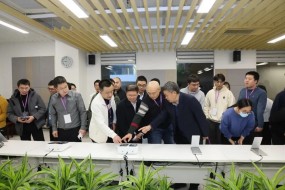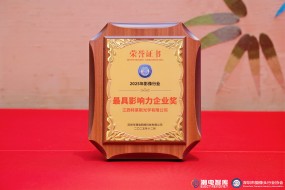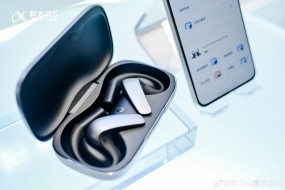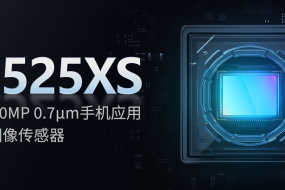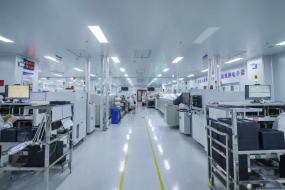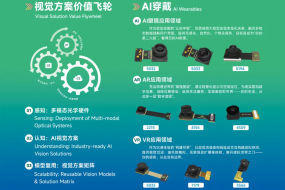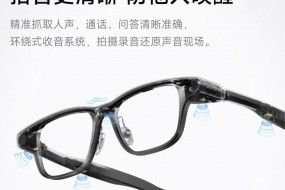以Oura去年出货量突破百万为标志,智能戒指赛道的魔力逐步显现。
根据媒体报道,三星今年发布的智能戒指Galaxy Ring计划于8月上市;苹果频频申请关于智能戒指的专利,迄今已经装满了一箩筐。不出意外的话,在这两大全球消费电子巨头的引领下,欧洲和北美的市场需求有望率先被引爆。
不过较为尴尬的现状是,欧美本土的智能戒指制造基本上为空白状态。
潮电智库从智能穿戴产业链了解到,雅为智能、魔样科技、友宏科技等中国智能戒指集成商已经布局欧美市场,力图在风口爆发前夕卡住有利身位。
其中,目前以雅为智能投入力度最大,出货量也最多。据公司COO古华龙介绍,“今年2月至今,我们的智能戒指已经成功出货20多万只,全年预定目标超百万级”。
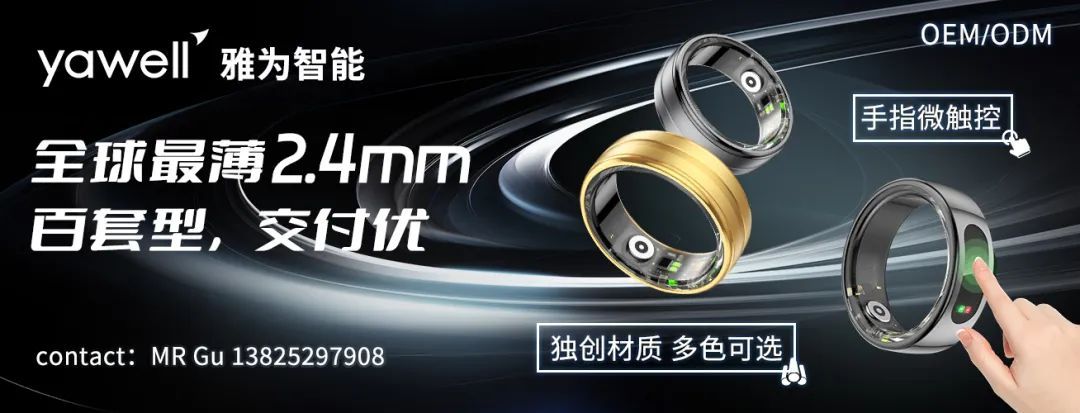 ntenteditable="false" style="box-sizing: border-box; vertical-align: middle; border-style: none; margin: 0px; padding: 0px; max-width: 100%;" alt="" />
ntenteditable="false" style="box-sizing: border-box; vertical-align: middle; border-style: none; margin: 0px; padding: 0px; max-width: 100%;" alt="" />
这样的目标,于产品形态、功能及场景应用,以及整体出货规模都尚处初级阶段的智能戒指市场而言,需要的不只是对赛道的信心,自身还须具备足够的产业实力。
在古华龙看来,成熟的制造工艺、充足的产能、稳定的交付、专业的服务等综合能力是雅为智能跃至戒指制造头部的关键。
值得注意的是,由于雅为智能的智能戒指产品出货价不到友商一半,某些规格甚至只有1/4,被部分企业玩家视为低价竞争。
但古华龙并不这么认为。
“我们非常看好智能戒指的市场前景,在新功能研发、开模、自动化产线、品控等各环节全力投入,追求的是长期主义。在产品业态发展初期,只有合适的、合理的定价才能让更多的用户来体验、把市场做大。”他解释说,雅为智能戒指价格更具竞争优势的原因,得利于灌胶封装等关键工序自动化生产使得我们的良率更高,产能更大。而且弧形电池等核心物料的自产,进而能更高效的成本控制。
事实上,从智能手表、TWS耳机,乃至智能手机等已经相对成熟的消费电子产品发展路径来看,前期无一不是以白牌或低价形式进行用户市场培育。
另一智能戒指厂商友宏科技,则在进行AI与产品融合的路线尝试。
在目前多种穿戴电子终端形态中,智能戒指与智能手表在功能与应用场景方面最为接近,但由于戒指体积更小,没有手表/手环的束缚感,不仅佩戴更为舒适,且非常适合交互设计。
对于研究健康及医疗级应用的穿戴电子来说,智能戒指还有非常重要的一个优点,即手指上的毛细血管更多,脉搏信号更强,比手腕上的监测数据更为准确可靠。
 ntenteditable="false" style="box-sizing: border-box; vertical-align: middle; border-style: none; margin: 0px; padding: 0px; max-width: 100%;" alt="" />
ntenteditable="false" style="box-sizing: border-box; vertical-align: middle; border-style: none; margin: 0px; padding: 0px; max-width: 100%;" alt="" />
因此,除了三星和苹果,荣耀、华米、黑鲨等品牌终端也在积极布局智能戒指。潮电智库认为,一旦智能戒指出货量迈入亿量级,其他大厂必将快速跟进。
公开数据显示,智能戒指品类在2023年的全球市场规模达2.1亿美元,同比增长16.7%,相比智能手表、TWS耳机和智能头显等其他穿戴电子品类,增长势头相当强劲。
市场调研机构指出,未来八年全球智能戒指市场复合年增长率将达24.1%,2032年至10亿美元。其中欧美是需求重地,预计出货占比超过七成。
据潮电智库了解,由于地域文化区别,目前欧美用户对于智能戒指存有NFC支付、智能交互、运动监测等共性需求。多家中国智能戒指制造商表示,在头部品牌企业的引领下,智能戒指的各种场景应用会逐步走向成熟并形成标准化。
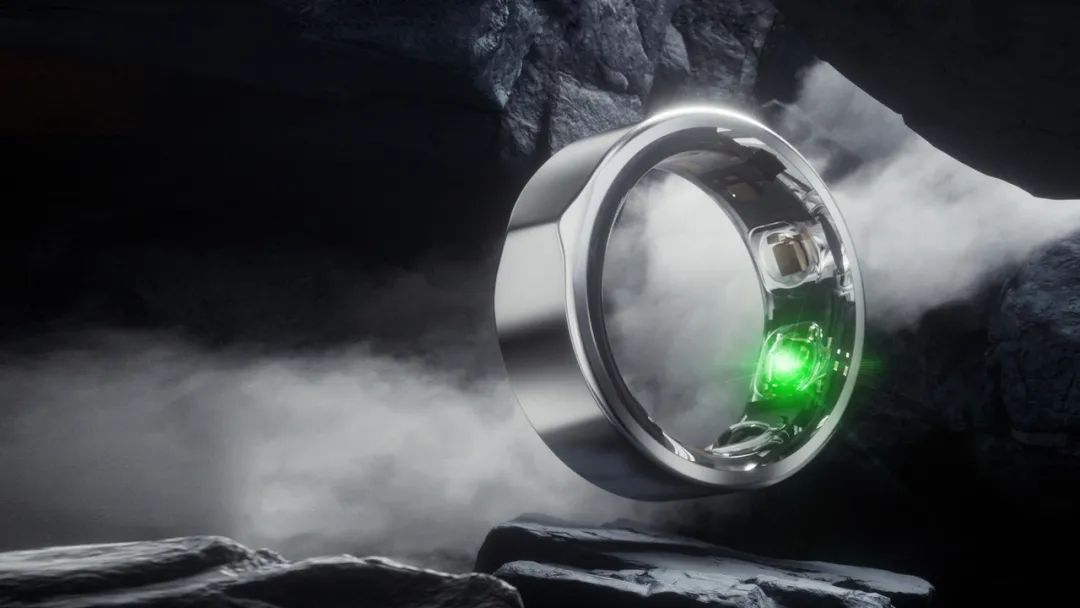 ntenteditable="false" style="box-sizing: border-box; vertical-align: middle; border-style: none; margin: 0px; padding: 0px; max-width: 100%;" alt="" />
ntenteditable="false" style="box-sizing: border-box; vertical-align: middle; border-style: none; margin: 0px; padding: 0px; max-width: 100%;" alt="" />
理性来看,作为智能穿戴的新品类,智能戒指市场目前总体处于起步阶段,比如目前的算法基本都是采用平移智能手表的模式,专注智能戒指算法的公司还没出现。
也正因为如此,智能戒指的发展前景有着更多的可能性,可能会成为又一个“小产品打出大市场”的经典之作。
但对于以雅为智能为代表的中国制造力量来说,他们的征途却早已开始,而且正在以“求先求变”的创新精神,坚定的走向远方的梦想。
China's Smart Ring Makers Expand to the US and Europe: Technical Challenges Overcome, Success Beckons
With Oura's shipment surpassing one million units last year, the allure of the smart ring sector is gradually emerging.
According to media reports, Samsung's Galaxy Ring is set to be released in August this year. Apple has also been filing numerous patents related to smart rings, filling an entire basket. It is expected that, under the leadership of these two global consumer electronics giants, the market demand in Europe and North America will be the first to be ignited.
However, the current situation is somewhat awkward as there is a near-blank state of smart ring manufacturing in Europe and North America.
From the smart wearable industry chain, Chaodian has learned that Chinese smart ring integrators such as YareWell Biotechnology, Moyoung Technology, and Youhong Medical have already laid out plans for the European and American markets, aiming to seize advantageous positions before the market boom.
Among them,YareWell Biotechnology has made the most significant investment and shipped the highest volume. According to COO Hualong Gu, "Since February this year, our smart rings have successfully shipped more than 200,000 units, with a target of over one million for the year."
Achieving such goals in the still nascent smart ring market requires not only confidence in the sector but also substantial industrial strength.
Hualong Gu believes that the key toYareWell Biotechnology's rise to the top in ring manufacturing lies in its comprehensive capabilities, including mature manufacturing processes, sufficient production capacity, stable delivery, and professional services.
It's worth noting thatYareWell Biotechnology's smart ring product shipment prices are less than half that of competitors, with some specifications being only a quarter of the price, leading some industry players to view this as low-price competition.
However, Hualong Gu disagrees with this perspective.
"We are very optimistic about the market prospects for smart rings. We invest heavily in new feature development, mold opening, automated production lines, and quality control, pursuing a long-term strategy. In the early stages of product form development, only appropriate and reasonable pricing can attract more users and expand the market," he explained. The competitive pricing of YareWell Biotechnology's rings is due to automated production in key processes like potting and encapsulation, which increases yield and capacity. Moreover, producing core materials like curved batteries in-house allows for more efficient cost control.
In fact, looking at the development paths of relatively mature consumer electronics products like smartwatches, TWS earphones, and even smartphones, the initial stages often involve white-label or low-price market cultivation.
Another smart ring manufacturer, Youhong Medical, is exploring the integration of AI with its products.
Among various wearable electronic terminal forms, smart rings and smartwatches have the closest functions and application scenarios. However, rings are smaller in size and do not have the constraints of watches or wristbands, making them more comfortable to wear and very suitable for interaction design.
For wearable electronics focused on health and medical applications, smart rings have a significant advantage: the abundance of capillaries on fingers provides stronger pulse signals, resulting in more accurate and reliable monitoring data compared to wrists.
Therefore, in addition to Samsung and Apple, brands like Honor, Huami, and Black Shark are also actively entering the smart ring market. Chaodian research believes that once smart ring shipments reach the hundreds of millions, other major manufacturers will quickly follow suit.
Public data shows that the global market for smart rings reached $210 million in 2023, a year-on-year increase of 16.7%. Compared to other wearable electronics categories such as smartwatches, TWS earphones, and smart headsets, the growth momentum is quite strong.
Market research institutions predict that the global smart ring market will grow at a compound annual growth rate of 24.1% over the next eight years, reaching $1 billion by 2032. Europe and North America are expected to be the major demand regions, accounting for over 70% of shipments.
According to Chaodian research, due to regional cultural differences, European and American users currently have common demands for NFC payment, smart interaction, and sports monitoring in smart rings. Several Chinese smart ring manufacturers have stated that under the guidance of leading brand companies, various application scenarios for smart rings will gradually mature and become standardized.
Rationally speaking, as a new category in smart wearables, the smart ring market is still in its early stages. For example, current algorithms are mostly adapted from smartwatches, and companies focused solely on smart ring algorithms have yet to emerge.
For this reason, the development prospects of smart rings hold more possibilities, potentially becoming another classic example of a "small product creating a big market."
For Chinese manufacturers like YareWell Biotechnology, their journey has already begun, driven by a spirit of innovation and determination to pursue distant dreams.










